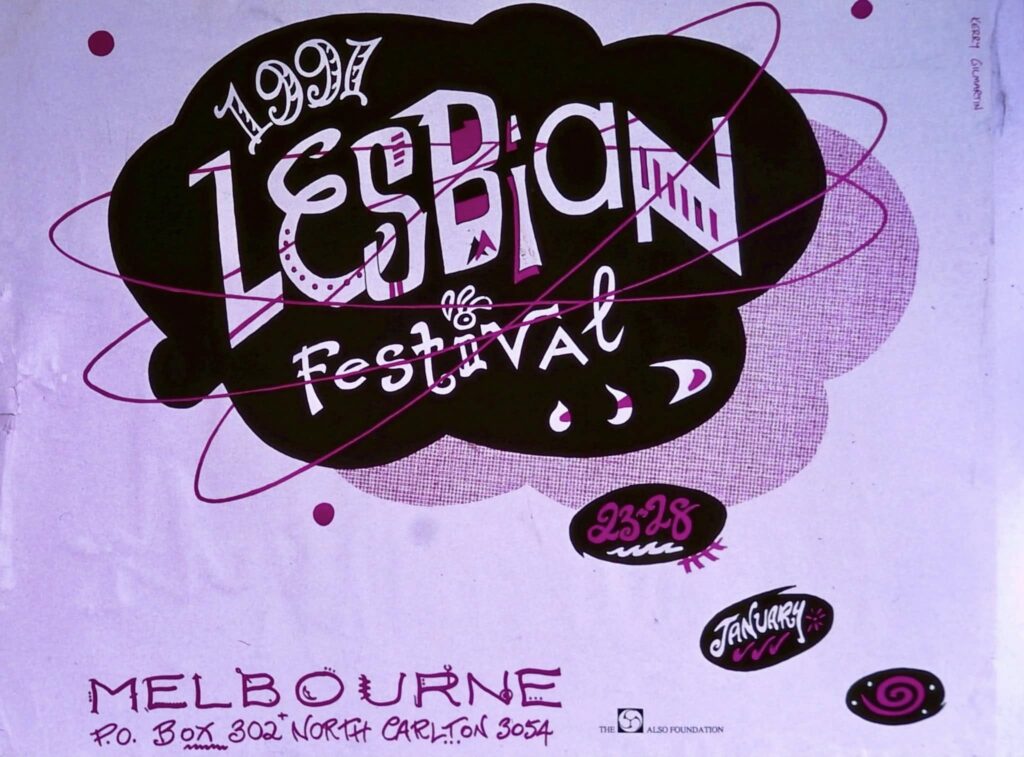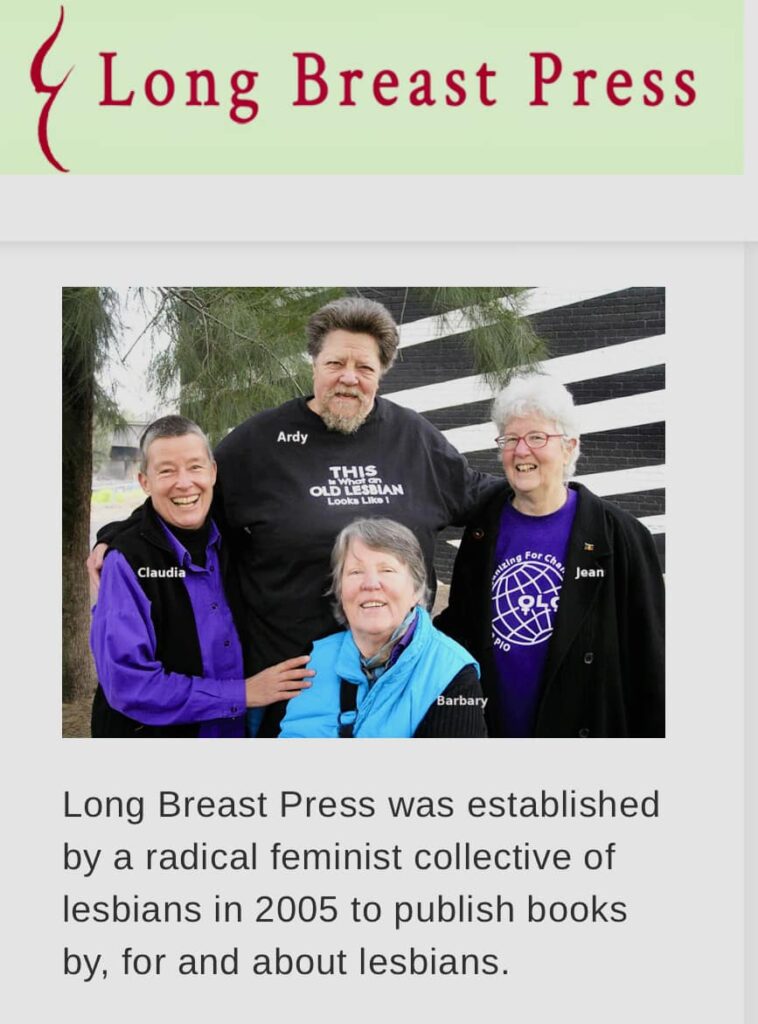Your cart is currently empty!
Reclaiming lesbian history and culture

Reclaiming lesbian history and culture
Lesbians have a rich culture and history. We are dismayed to see this being eroded as the push to include men in our spaces gathers pace. This page gives a snapshot of what we had, and what has been lost through the voices of lesbians. Here you will find personal stories, a slideshow of images from the past, a radicalesbian herstory and an account of lesbian activism from the 80s.
I’m a lesbian aged 75. When I moved to Melbourne in my middle age, the vibrancy of lesbian social and political life was very affirming. Our community had lesbian cafes, discussion groups, theatre, concerts, sports teams, pub nights, games, businesses, archives, publications like Lesbiana and Journal of Australian Lesbian Feminist Studies. Continue
All this was organised by lesbians for lesbians. We had annual residential camps until a particularly mean-spirited transwoman blocked us legally, forcing us underground, and back into the 1950s closets. Lesbians need to be able to meet with lesbians to experience, discuss and enjoy lesbian culture. And we now need to defend our spaces from males emboldened by homophobic Gender Self ID laws. Friends report that about a third of people on lesbian dating sites are such men. They call us transphobic if we refuse to “Suck my lady dick”
When I first came out in the early 1980s there was a new but thriving and supportive lesbian culture where lesbians and other women could meet at women-only dances and other public gatherings. Continue
After the Sex Discrimination was amended to include gender identity as a protected characteristic, there has been no government acknowledgement of the devastating effect of this change on lesbians and other women. Insufficient thought had obviously gone into this significant change that was based on blind denial of biological facts, as conflicting rights were invoked with no suggested ways to deal with them.
As a result, lesbians in Australia have lost our rights of association. We have become isolated from each other, having to meet ‘underground’ (like in the old days of ostracism and homophobia), which has led to deteriorating mental health and significant losses to our culture and personal safety. I am fortunate in having already established supportive lesbian networks, but younger lesbians have become cut adrift, struggling to claim their lesbian identity, subject to the confusion of queer theory where (mainly heterosexual) men with a fetish are propositioning them by claiming to be lesbians with female ‘dick’ and/or being besieged with claims that lesbians can easily become men and ‘trans the gay away’ into a façade of more acceptable heterosexual relations with other women.
When I came out as a lesbian in the late 1980’s and early 1990’s I was welcomed into a thriving community of women. That community has helped and supported me through a range of life experiences, especially those experiences of exclusion that were prevalent at that time. In the intervening years and on the basis of my lesbianism I have been physically assaulted; verbally abused; refused service; stared at in public; asked to leave premises; lost employment opportunities and ostracised at work. Continue
While these were unpleasant experiences, they are experiences that I share with other lesbians, especially those that do not conform to regressive gender stereotypes about what women should do, how they should behave and how they should dress. While these experiences have been profoundly negative, they are common among lesbians and have developed a steely resilience within myself and my community.
While I was welcomed into a thriving community of women, I have grown increasingly troubled over the past few years about young lesbians joining my community. Lesbians are a small and marginalised group within the broader community and forcing us back underground where we again employ the use of passwords and vouching systems is regressive and robs us of our right to free assembly. It is akin to lesbian life in the 1950’s and has no place in contemporary society. It robs us of the connection with our young counterparts who are denied an understanding of their culture and rich history, which was a connection that I so thoroughly benefited from. As lesbians we are no longer able to meet up as women with a common bond without the presence of men who do not share our experiences of the world.
I realised I was a lesbian later in life and had trouble ‘finding my community’. Eventually I found Lynx social club, which for two decades +, including the ’80s & ’90s, provided an absolutely essential weekly meeting place for lesbians. Continue
Although I lived on the south side of the city, when I first came out I just about lived in The Angel Cafe (in Brunswick St, Fitzroy) and Shrew Bookshop and Gertrude’s Giftshop, both of which were in Gertrude St Fitzroy. I think I bought about half of Shrew’s books while I was familiarising myself with the ‘theory’ of lesbianism (and numerous trashy lesbian novels).
In the late ’80s & early ’90s, every Friday night, Stewarts Hotel in Carlton had a lesbians-only dance that was sorely missed when it closed. There were also weekly lesbian-only dances at the Sarah Sands Hotel and The Ivy in the city. If you preferred to play pool, there was The Glasshouse in Collingwood or The Inkspot (in Elsternwick).
Matrix Guild Victoria’s annual fundraiser for advocacy for Lesbians Over 40, the Satin and Silk Ball at San Remo Ballroom, was a well-loved yearly highlight the early ’90s, with a live band and supper. It was unique because lesbians wore everything from satin ballgowns (sometimes accompanied by Doc Marten boots), to tuxedos or tails or tradie gear. Mix-and-match, limited only by the imagination.
The Lesbian Cancer Support Group ran from 1996 to 2005, providing invaluable emotional support not only to lesbians who had cancer, but also to carers and bereaved partners (of which I was one). We received a small amount of funding, the last part of which was used to run the Lesbian Health Across the Lifespan Conference, covering many aspects of lesbian human rights and health, in 2005.
I loved going to Lesboraves, a monthly political lesbian discussion group in Collingwood in the early ’90s. It was absolutely essential for us to have these lesbian-only spaces, in order for us to be able to speak freely without fear of being judged, spoken over, or told that our lesbian-specific issues (such as legal discrimination) were not important.
I am desolated that NONE of these places/events exist any more!
LESBIAN FEMINIST CULTURE
This is the slideshow Chris Sitka presented at the TLC ‘Standing Our Ground’ conference 13/10/24. Thanks to Tashe Long & Sarah Yeomans for contributions, and to Jean Taylor for decades of archiving. The slideshow theme was ‘Lesbian Feminist Culture’.
A RADICALESBIAN HERSTORY by Chris Sitka
The following is an account of the beginnings of lesbian feminism in Australia. It is primarily the story of the first National Lesbian Feminist Conference ever held in Australia which took place near Melbourne at a place called Sorrento on July 6 – 8th in 1973.
Click here to read the article
Cockburn Sound (Perth) protest against nuclear warships, with Women for Survival 1984
Lesbians are everywhere. Truly. We’ve been visibly active in campaigns for women’s refuges, abortion rights, asylum seekers, peace, myriad environment actions, AIDS care, cancer support, United Nations delegations, recognition of rape in all wars, against nuclear energy……
Women for Survival was a 99% lesbian initiative that in 1984 organised a Peace Train from Sydney to Perth, collecting activists on the way, to protest the docking of US ships with nuclear warheads. We set up an enormous lesbian camp (with other peace groups in separate areas) – below is a hessian portrayal I made of my housemates who couldn’t come, which hung on my tent. For months before we set off, my affinity group – called Mermaids with Muscle – trained at Leichhardt pool with laps and synchronised swimming. Our plan was to create a ‘ban the bomb’ symbol in the water beside the jetty. And this we most wonderfully did, with animal floaties round our waists, and loud song. Of course then we had to climb up the sea wall into the arms of the coppers who very roughly transported us to jail for a night. The following morning we were released to get back to camp and dress, then report to court. We’d spent the whole night rehearsing our speeches, in snatches, unnecessarily as it turned out. I was wearing my sailors’ hat with ‘Kiss a Mermaid, Not a Sailor’ and long red plaits.




We’re lesbians. Of course there were meetings, music, sex, dancing, feasting, bonfires.
My nostalgia for the lesbian glory days has been stimulated by visits to the Victorian Women’s Liberation and Lesbian Feminist Archives at UniMelb. I thank Jean Taylor and the Archives Collective for their creation and curatorship over decades. If you’d like to visit the archives, email me sjmyeomans@gmail.com and I’ll talk you through the (easy) process. Written by Sarah Yeomans.





















































